This content was published: September 29, 2022. Phone numbers, email addresses, and other information may have changed.
Charged Voids Essay
Posted by Christine Weber
Avantika Bawa | Charged Voids
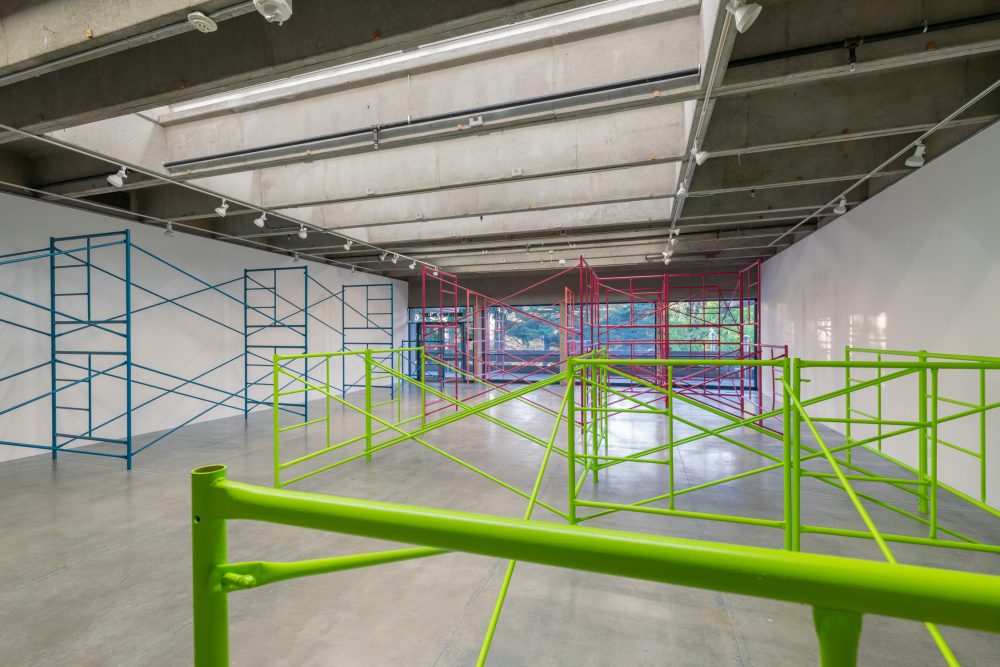
Avantika Bawa, Charged Voids, scaffolding of varying colors and dimensions, site-specific installation in the North View Gallery, PCC Sylvania, 2022 (Photograph: Mario Gallucci)
In Charged Voids, Avantika Bawa employs the staging and support structures used in the construction process to consider what is already constructed in new ways. Bawa spent a month in residence at the North View Gallery, on the PCC Sylvania campus, installing a new iteration of her Scaffold Series in response to the architecture. The gallery occupies one of the original 1968 Brutalist buildings at Sylvania, furthering the exploration Bawa began with A Brutal Affair, a series of drawings and prints inspired by the monumental rawness of Brutalist structures around the world, including in her hometown New Delhi. This exhibition merges these series for the first time.
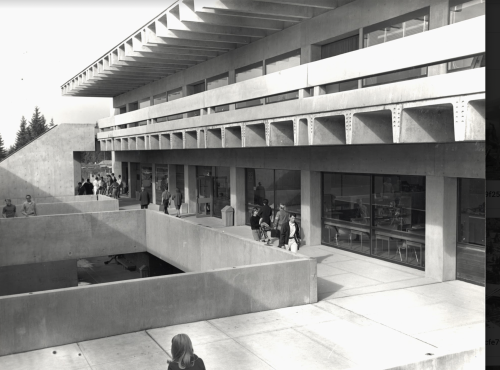
Historical photograph of the walkways on the PCC Sylvania Campus. 1968-1970. (Collection of the PCC Library)
Brutalism’s simplified, modular shapes and raw concrete form the core of the Sylvania campus. Concrete walkways surround and connect the original Sylvania buildings functioning as the pedestrian and communal spaces described as “charged voids” by UK architects Alison and Peter Smithson. In fact, one of these concrete walkways borders the North View Gallery. Most classrooms in the early buildings were once visible through large windows from these exterior walkways (now many of the windows are frosted). In keeping with the principles of openness and transparency important to the first college president, Amo DeBernardis, floor to ceiling windows span both ends of the North View, allowing maximum visibility into the gallery. While the north facing windows reduce the barrier between interior and exterior, Avantika further dematerializes that boundary by placing a scaffold outside and painting the same salmon pink as a scaffold on the inside, near the emergency exit.
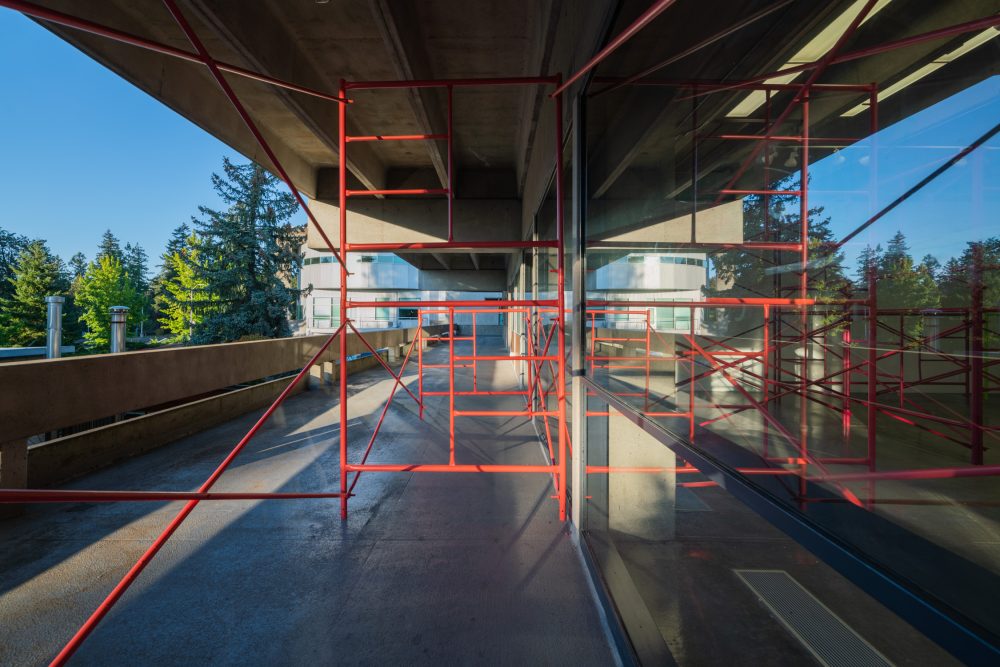
Avantika Bawa, Charged Voids, detail of scaffolding outside on the walkway, site-specific installation in the North View Gallery, PCC Sylvania, 2022 (Photograph: Mario Gallucci)
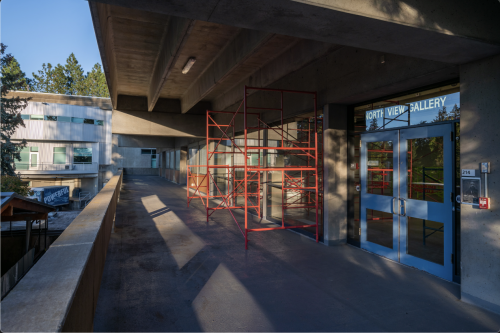 Remarkably, that emergency exit was once a gallery entrance. Students with classes on the north side of the building could visit the gallery with ease. People gave directions that required walking through the gallery on the way to a class or meeting. Eventually, to secure the gallery against theft, the north exit door was alarmed, closing that path through the building. Bawa decided to reopen the path for this exhibition, turning off the alarm and encouraging viewers to spend time in the charged void outside the gallery walls. The alarm is challenging to disarm and has been infrequently tripped during the installation of the show. The alarm may even sound while you are reading this essay, charging the installation with memories of how people once moved through the space.
Remarkably, that emergency exit was once a gallery entrance. Students with classes on the north side of the building could visit the gallery with ease. People gave directions that required walking through the gallery on the way to a class or meeting. Eventually, to secure the gallery against theft, the north exit door was alarmed, closing that path through the building. Bawa decided to reopen the path for this exhibition, turning off the alarm and encouraging viewers to spend time in the charged void outside the gallery walls. The alarm is challenging to disarm and has been infrequently tripped during the installation of the show. The alarm may even sound while you are reading this essay, charging the installation with memories of how people once moved through the space.
Avantika herself charges the gallery with the complicated, abstract forms created by the scaffolds. Angled crossbars echo the diagonal lines of the gridded gallery skylight. The horizontal lines of the scaffolds reinforce; and the vertical lines salute the concrete ceiling beams of the massive Brutalist building. And yet, Bawa’s color palette infuses the space with playfulness and delight. The scaffolding radiates, casting complicated shadows, along with a teal green veil on the west wall and subtle hints of hot pink and electric green on the east. If you look long enough, afterimages add an extra layer of complementary color to this elaborate composition.
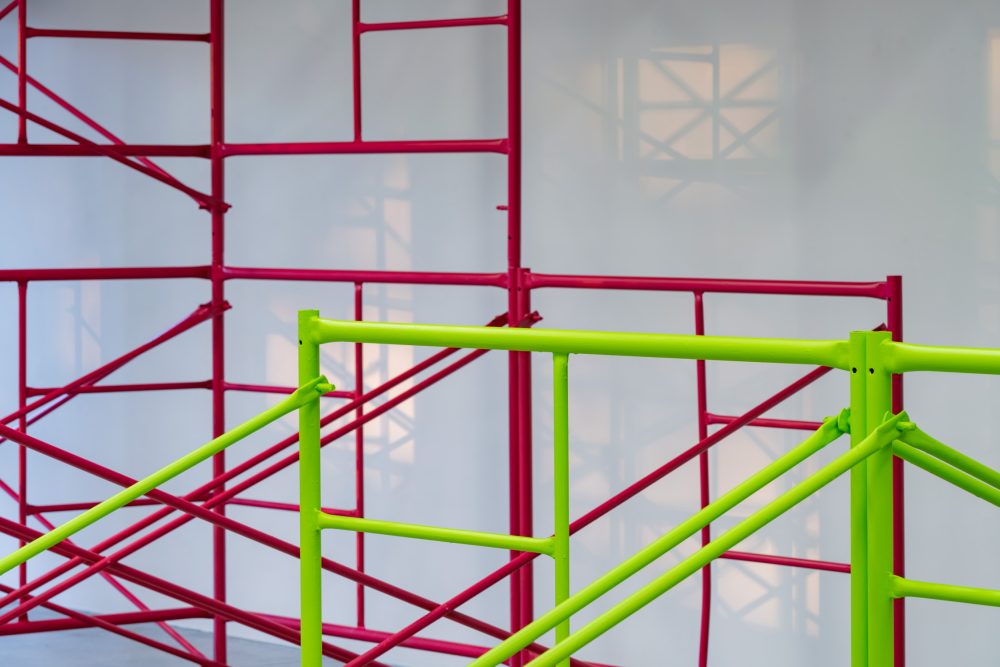
Avantika Bawa, Charged Voids, detail of pink and green scaffolds, site-specific installation in the North View Gallery, PCC Sylvania, 2022 (Photograph: Mario Gallucci)
The vibrant hues Bawa introduces to the white-walled gallery are drawn from her interest in color theory. They also reference the brilliant colors of traditional Indian saris. This connection proposes a dialogue between the machine-made industrial material of the scaffold and the intimate process of hand-dying and sewing women’s clothing in India. Both materials are constructed and deconstructed often during their lifespan. A sari starts as a long piece of fabric that is carefully folded multiple times to fit a woman’s body, then unfolded when disrobing. Scaffolds start as modular pieces, but they too are assembled for use, then dismantled and reassembled again. The fact that each scaffold in this installation was hand-painted during Bawa’s residency charges the voids even further with the labor of the human hand.
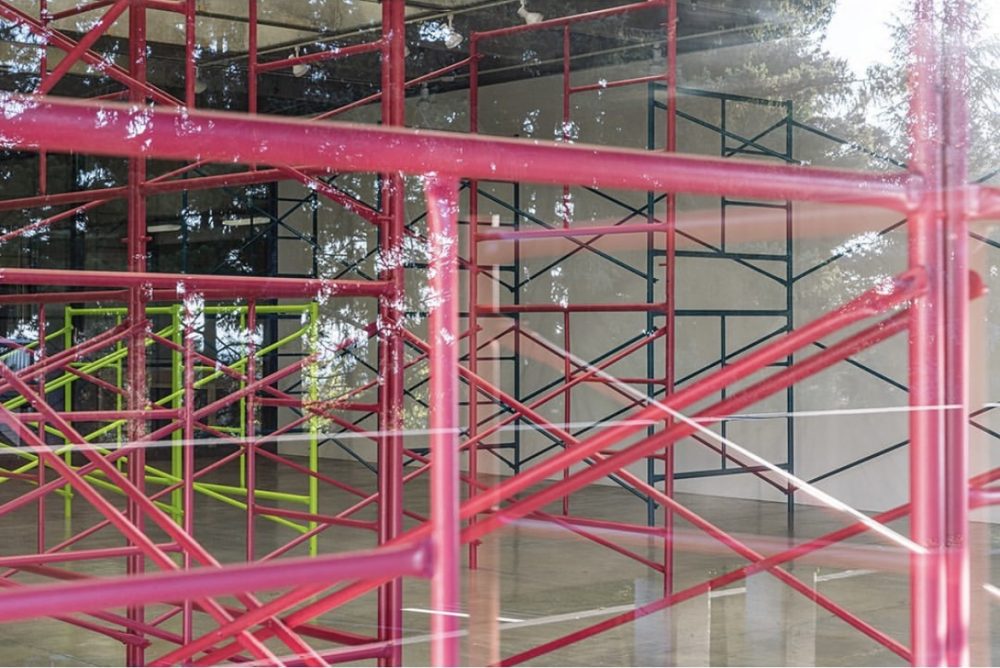
Avantika Bawa, Charged Voids, detail of scaffolding in the gallery, site-specific installation in the North View Gallery, PCC Sylvania, 2022 (Photograph: Mario Gallucci)
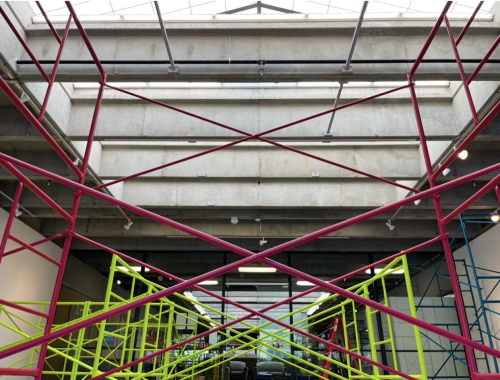 Viewers are also invited to charge the gallery with their presence. Bawa’s work allows everyone to bring their own vision, understanding, and poetry to the space she creates. Charged Voids can be a purely formal experience. It can encourage meditation on the function of scaffolding, recalling the scaffolds used when the building was first constructed and currently in use on the renovation of the Health Technology building next door. What are the differences between those functional objects and the ones installed in the gallery? The scaffolds may evoke the framing of history and the scaffolding of knowledge that takes place in an institution of higher education. Bawa is herself a committed educator, teaching studio art and working on the gallery team at Washington State University in Vancouver. Finally, the scaffolding might draw our attention to the gallery itself and to how our bodies move through that space. Charged Voids engages viewers physically, proposing new ways of being in the gallery, lying on the floor to watch the diagonal crossbars echo the lines of the skylight, or climbing high to view the gallery from above.
Viewers are also invited to charge the gallery with their presence. Bawa’s work allows everyone to bring their own vision, understanding, and poetry to the space she creates. Charged Voids can be a purely formal experience. It can encourage meditation on the function of scaffolding, recalling the scaffolds used when the building was first constructed and currently in use on the renovation of the Health Technology building next door. What are the differences between those functional objects and the ones installed in the gallery? The scaffolds may evoke the framing of history and the scaffolding of knowledge that takes place in an institution of higher education. Bawa is herself a committed educator, teaching studio art and working on the gallery team at Washington State University in Vancouver. Finally, the scaffolding might draw our attention to the gallery itself and to how our bodies move through that space. Charged Voids engages viewers physically, proposing new ways of being in the gallery, lying on the floor to watch the diagonal crossbars echo the lines of the skylight, or climbing high to view the gallery from above.
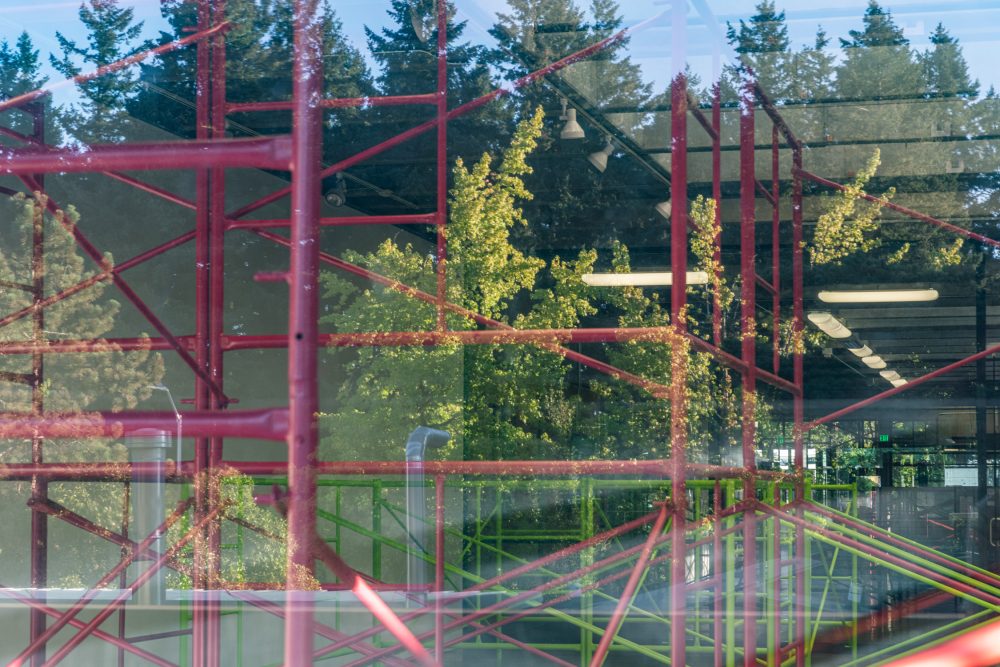
Avantika Bawa, Charged Voids, detail of scaffolding looking into the gallery from outside, site-specific installation in the North View Gallery, PCC Sylvania, 2022 (Photograph: Mario Gallucci)
The Scaffold Series lives in the expanded field. We become more aware of our own human form as we move through Avantika’s space. This, along with the scaffold’s modularity and geometric abstraction, relates Bawa’s work to Minimalism and to early 20th-century modernists, particularly modernist designers who created immersive abstract interiors. While informed by a modernist aesthetic, Bawa is also interested in contradictions, in the fact that repetitive modularity is often full of irregularities. The scaffold has grid-like features, but the form is asymmetrical and made dynamic by diagonal lines that create intense visual rhythm in the ways Avantika has positioned them. Of course, modernist movements are rife with contradictions. Avant-garde groups had utopian ideals that were difficult, if not impossible to realize. For example, Bauhaus designers identified as egalitarian radicals yet upheld patriarchal inequities in the very structure of their design school.
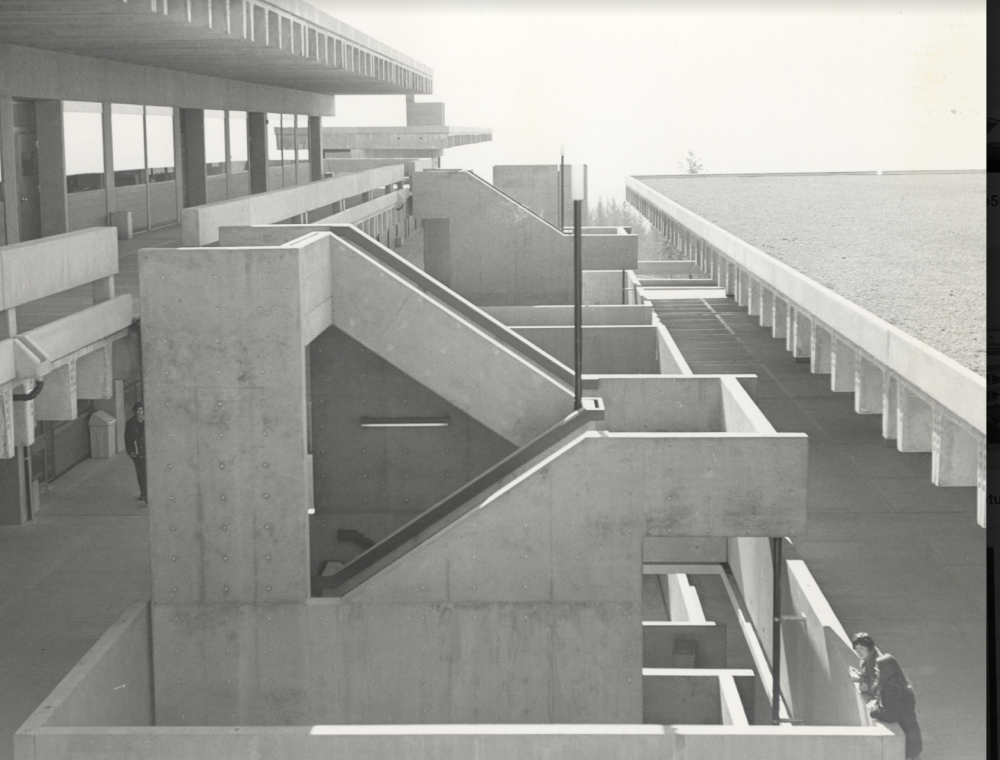
Walkways on the PCC Sylvania Campus. Photograph from the PCC Library Archives. 1968-1970.
Brutalism, as a late modernist architectural style, also features abundant contradictions. The term took its name from the French béton brut, or raw concrete, demonstrating the honesty of buildings that don’t try to hide their materials or structure. Brutalism too was a hopeful, utopian style. Architects like the Smithsons designed buildings to address human social and communal needs, yet many decry Brutalist buildings as cold and impersonal, giving new meaning to the word brut. Brutalism began as a functional solution to rebuilding Europe after the devastation of World War II, but what is the role of brutalist buildings today in the context of the climate crisis? What is the role of Brutalist buildings described as alienating, at a time when human relationships and connection to our surroundings feel more important than ever? How can the thinkers, artists, and workers at Portland Community College create spaces of belonging on a campus that feels designed to confuse and disconnect?
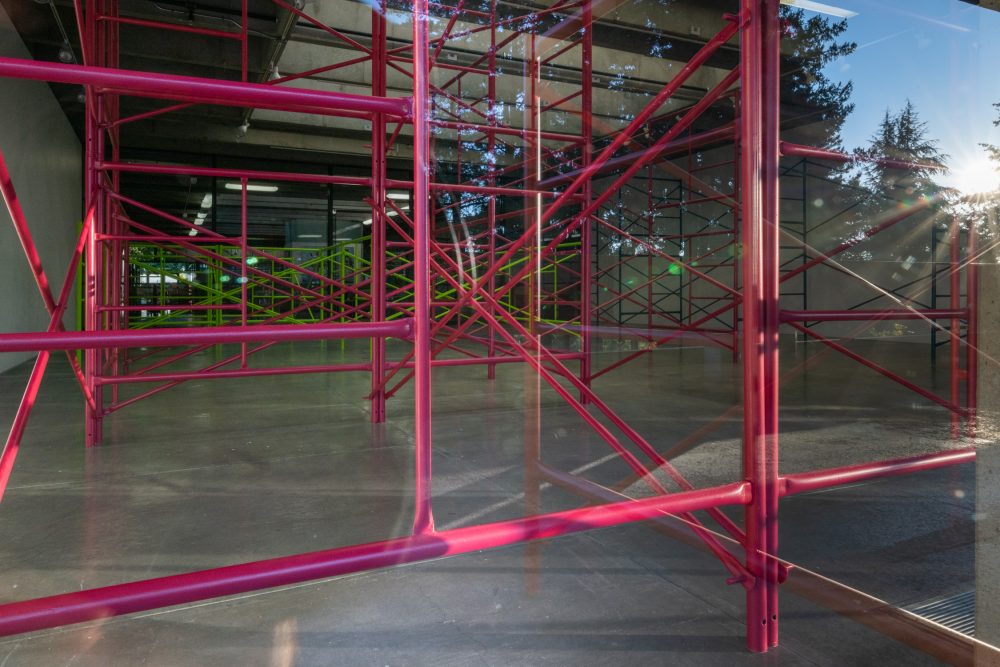
Avantika Bawa, Charged Voids, detail of scaffolding looking into the gallery from outside, site-specific installation in the North View Gallery, PCC Sylvania, 2022 (Photograph: Mario Gallucci)
In their book, The Charged Void, the Smithsons wrote about their attempt ‘to drag a rough poetry out of the confused and powerful forces which are at work in a mass production society.’ This attempt resonates with the everyday poetry that Bawa exposes in the functional form of the scaffold, a form that allows humans to reach new heights, that makes back-breaking labor possible, and that can frame and reframe spaces. What kind of poetry happens when these functional objects occupy the charged voids of Brutalism? How do they help us see the college campus and the gallery with new eyes? How do the scaffolds draw our attention to the history of the campus and to the present renovations the campus is undergoing? What will the future of the PCC Sylvania campus look like, and where will its historic Brutalist buildings fit into that future? At a time when many people are returning to Portland Community College campuses for the first time since 2020, Bawa’s installation provides a scaffolding around which the college community can come together and engage in meaningful conversations about place and history.
Christine Weber, North View Gallery Director
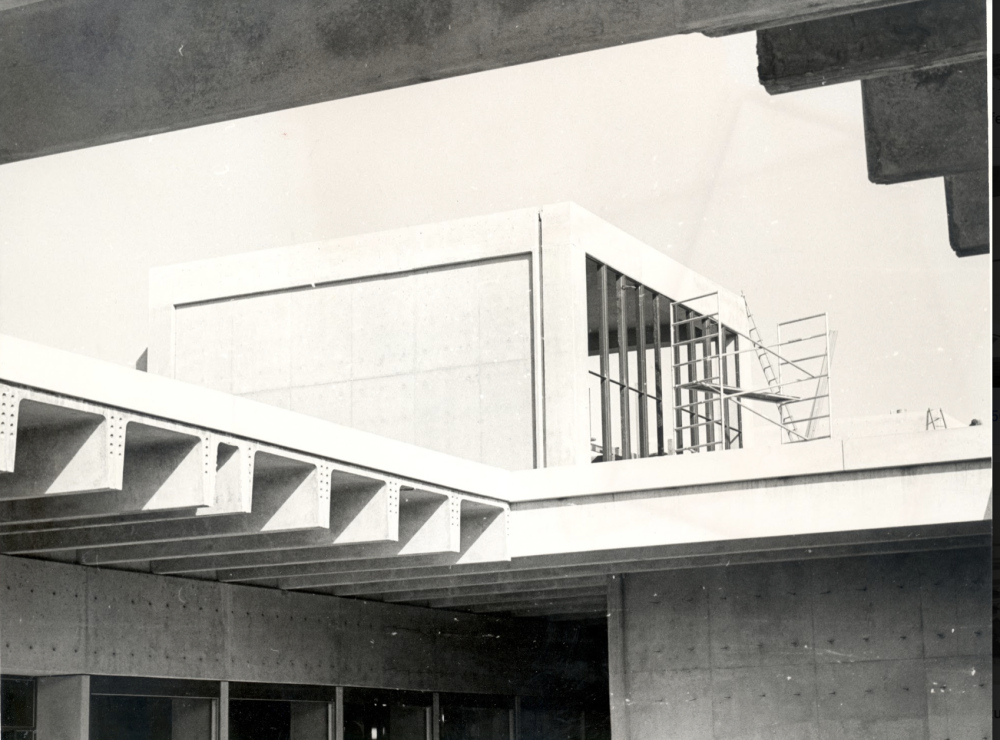
Historical photograph of the PCC Sylvania campus under construction with scaffolds on the roof in 1968.
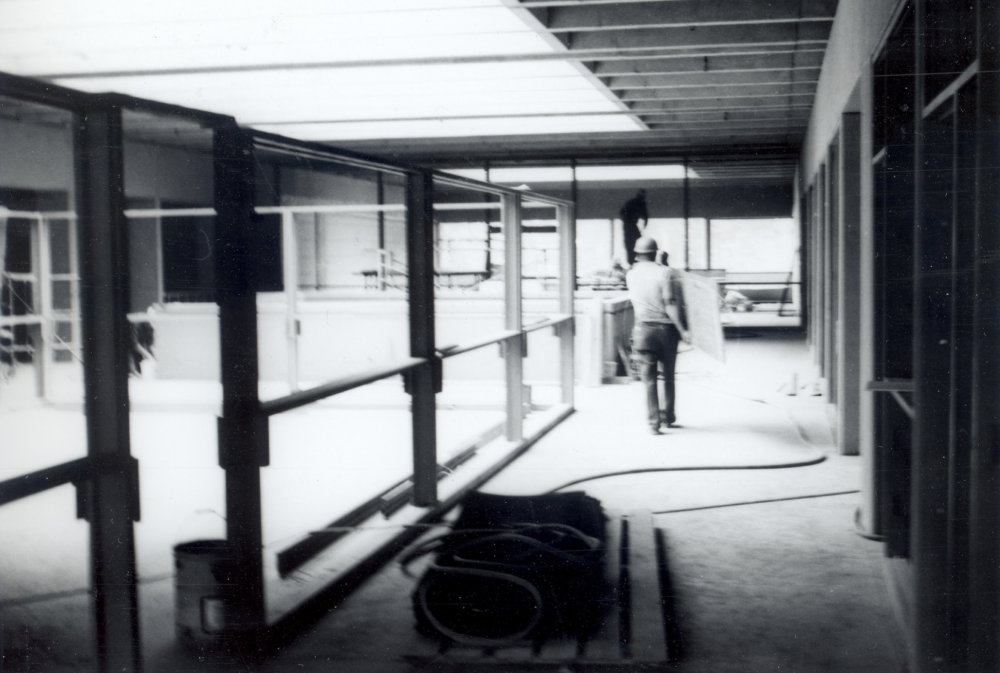
Photograph of the CT building under construction with a view into the North View Gallery. 1968.
